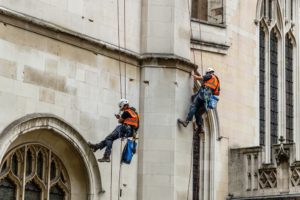 Falls from height are one of the biggest causes of workplace fatalities and major injuries. Common causes are falls from ladders and through fragile roofs. The purpose of Work at Height Regulations is to prevent death and injury from a fall from height.
Falls from height are one of the biggest causes of workplace fatalities and major injuries. Common causes are falls from ladders and through fragile roofs. The purpose of Work at Height Regulations is to prevent death and injury from a fall from height.
Work at height means work in any place where, if there were no precautions in place, a person could fall a distance liable to cause personal injury. For example, you are working at height if you:
- Are working on a ladder or a flat roof;
- Could fall through a fragile surface;
- Could fall into an opening in a floor or a hole in the ground.
There may be some low-risk situations where common sense tells you no particular precautions are necessary and the law recognises this. It is important to take a common sense approach.
There is also a common misconception that ladders and stepladders are banned, but this is not the case. There are many situations where a ladder is the most suitable equipment for working at height.
Before working at height you must work through these simple steps:
- Avoid work at height where it is reasonably practicable to do so;
- Where work at height cannot be avoided, prevent falls using either an existing place of work that is already safe or the right type of equipment;
- Minimize the distance and consequences of a fall, by using the right type of equipment where the risk cannot be eliminated.
You should:
- Do as much work as possible from the ground;
- Ensure workers can get safely to and from where they work at height;
- Ensure equipment is suitable, stable and strong enough for the job, maintained and checked regularly;
- Make sure you don’t overload or overreach when working at height;
- Take precautions when working on or near fragile surfaces;
- Provide protection from falling objects;
- Consider your emergency evacuation and rescue procedures.
If you are an employer or you control work at height (for example if you are a contractor or a factory owner), the Working at Height Regulations apply to you.